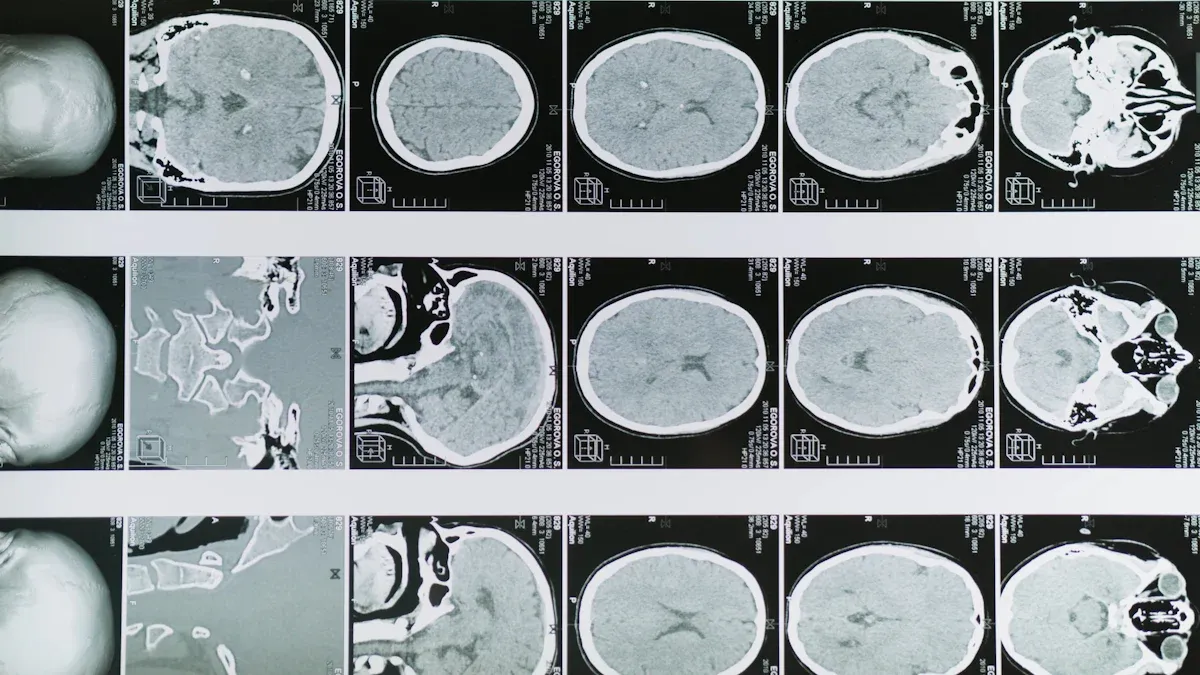What Are the Symptoms of Paranasal Sinus and Nasal Cavity Cancer

Paranasal sinus and nasal cavity cancer is a rare condition, accounting for only 3% to 5% of all head and neck cancers in the United States. It occurs more frequently in certain regions, such as Denmark, and affects men about twice as often as women. Risk factors include exposure to harmful substances like nickel, chromium, or volatile hydrocarbons, as well as tobacco use and chronic sinusitis. Recognizing early symptoms, such as nasal congestion or facial pain, can help you seek timely medical attention and improve outcomes.
Key Takeaways
Notice early signs like a stuffy nose or face pain. These can help you get medical care sooner.
Don't ignore frequent nosebleeds or changes in smell. They might mean something serious is wrong.
Watch for strange swelling or bumps on your face or nose. These could be signs of advanced cancer.
See a doctor if symptoms last over a few weeks. Finding it early can make treatment work better.
Stay away from harmful things like smoking and chemicals. This can help lower your chances of getting this cancer.
Early Symptoms of Paranasal Sinus and Nasal Cavity Cancer

Nasal Congestion
Persistent congestion on one side
You might notice nasal congestion that doesn’t improve over time. Unlike congestion caused by allergies or colds, this type often affects only one side of your nose. It can feel like a constant blockage, making it harder to breathe. Chronic sinus infections that don’t respond to antibiotics may also accompany this symptom.
Difficulty breathing through the nose
Breathing through your nose may become increasingly difficult. This can happen even when you don’t have a cold or other common respiratory issues. If you experience this symptom for weeks without relief, it’s important to pay attention.
Nosebleeds
Frequent or unexplained nosebleeds
Frequent nosebleeds can be an early sign of paranasal sinus and nasal cavity cancer. These nosebleeds often occur without any clear cause, such as trauma or dry air. You might also notice mucus mixed with blood or pus draining from your nose.
Facial Pain or Pressure
Pain around the eyes, cheeks, or forehead
Facial pain or pressure is another common symptom. You may feel discomfort above or below your eyes, in your cheeks, or across your forehead. This pain can sometimes mimic sinus headaches but doesn’t go away with typical treatments. In some cases, the pain may extend to your upper teeth or jaw, making it harder to pinpoint the exact source.
Tip: If you experience persistent facial pain or pressure, especially alongside other symptoms like nasal congestion or nosebleeds, consult a healthcare professional. Early detection can make a significant difference in treatment outcomes.
Changes in Smell or Taste
Reduced or complete loss of smell
A noticeable change in your sense of smell can be an early sign of paranasal sinus and nasal cavity cancer. You might find it harder to detect familiar scents, or you could lose your sense of smell entirely. This symptom often develops gradually, making it easy to overlook. Unlike temporary changes caused by colds or allergies, this loss persists and doesn’t improve with over-the-counter treatments.
Note: If you experience a persistent reduction in your ability to smell, especially alongside other symptoms like nasal congestion or nosebleeds, consult a healthcare provider promptly.
Other Subtle Symptoms
Watery eyes or excessive tearing
You may notice your eyes watering more than usual. This symptom can occur even when you’re not exposed to irritants like smoke or allergens. Excessive tearing often accompanies other signs, such as nasal congestion or facial pain. It might seem minor, but it could indicate a deeper issue.
Mild swelling in the face or nose
A slight swelling in your face or around your nose might also signal a problem. This swelling can appear near your cheeks, eyes, or nasal bridge. It may feel tender or firm to the touch. While mild swelling might seem harmless, it’s important to monitor it, especially if it worsens or doesn’t go away.
Tip: Subtle symptoms like watery eyes or mild swelling are often overlooked. Pay attention to these changes, as they could be early indicators of paranasal sinus and nasal cavity cancer.
Some subtle symptoms, such as nasal congestion, nosebleeds, or changes in smell, are easy to dismiss as minor issues. However, these signs can persist or worsen over time. If you notice any of these symptoms, don’t ignore them. Early detection plays a crucial role in improving treatment outcomes.
Advanced Symptoms of Paranasal Sinus and Nasal Cavity Cancer

Severe Facial Swelling or Deformity
Noticeable lumps or growths in the face or nose
As paranasal sinus and nasal cavity cancer progresses, you may notice visible changes in your face or nose. Lumps or growths can develop, often appearing firm or irregular. These changes may result from the tumor invading nearby structures, such as the maxillary sinus or nasal cavity walls. Severe swelling or deformity might also occur on one side of your face, making it appear asymmetrical.
Note: If you observe any unusual lumps or swelling that persist or worsen, consult a healthcare provider immediately.
Vision Changes
Blurred or double vision
Advanced stages of this cancer can affect your vision. You might experience blurred or double vision, which can make daily tasks challenging. This happens when the tumor spreads to areas near the eyes, such as the orbit, causing pressure or damage.
Loss of vision in one eye
In some cases, you could lose vision in one eye entirely. This symptom often indicates significant tumor growth affecting the optic nerve or surrounding tissues. Vision changes like these should never be ignored, as they may signal a serious underlying condition.
Persistent Pain
Severe or worsening facial pain
Facial pain can intensify as the cancer advances. You might feel constant or sharp pain around your cheeks, forehead, or eyes. This pain often doesn’t respond to typical pain relievers and may worsen over time.
Pain radiating to the teeth or jaw
The pain may also spread to your upper teeth or jaw, making it difficult to chew or speak. Some people report loose teeth or discomfort that mimics dental issues. These symptoms occur when the tumor invades nearby nerves or bone structures.
Tip: Persistent or worsening pain, especially when combined with other symptoms, should prompt you to seek medical attention. Early intervention can improve outcomes.
Neurological Symptoms
Numbness or tingling in the face
You might experience numbness or tingling in parts of your face as paranasal sinus and nasal cavity cancer progresses. This symptom often occurs on one side and may feel like a persistent loss of sensation or a pins-and-needles sensation. It happens when the tumor affects nearby nerves, leading to cranial neuropathies. Other related symptoms, such as unilateral facial swelling or trouble with your sense of smell, may accompany this numbness.
Difficulty moving facial muscles
Difficulty moving facial muscles can also signal advanced stages of this cancer. You might notice trouble smiling, frowning, or performing other facial movements. This occurs when the tumor invades the nerves controlling facial expressions. In some cases, this symptom may combine with other neurological issues, such as blurred vision or bulging of one eye.
Note: Neurological symptoms like these should not be ignored. They often indicate significant tumor growth and require immediate medical attention.
Other Advanced Signs
Persistent ear pain or hearing loss
Persistent ear pain or hearing loss can develop as the tumor spreads to nearby structures. You might feel a constant ache in one ear or notice difficulty hearing. This symptom often accompanies other signs, such as sinus pressure, headaches, or nasal blockage.
Unexplained weight loss or fatigue
Unexplained weight loss and fatigue are common in advanced stages of paranasal sinus and nasal cavity cancer. You might lose weight without trying or feel constantly tired, even after adequate rest. These symptoms often result from the body’s response to the cancer and its impact on your overall health. Other signs, such as enlarging lymph nodes in the neck or a sore inside the nose that doesn’t heal, may also appear.
Tip: If you notice persistent ear pain, hearing loss, or unexplained weight changes, consult a healthcare provider promptly. Early intervention can improve your treatment outcomes.
When to Seek Medical Attention for Paranasal Sinus and Nasal Cavity Cancer
Persistent or Worsening Symptoms
Symptoms lasting more than a few weeks despite treatment
You should pay close attention to symptoms that persist or worsen over time. Signs like nasal congestion, sinus pressure, or facial pain that do not improve with standard treatments may indicate a more serious condition. Other concerning symptoms include a runny nose, frequent nosebleeds, or a lump inside the nose that doesn’t heal. These issues often mimic less severe conditions, but their persistence is a key warning sign.
Tip: If you notice symptoms lasting more than a few weeks, consult a healthcare provider. Early evaluation can help rule out serious conditions like paranasal sinus and nasal cavity cancer.
Alarming Signs
Severe nosebleeds or facial swelling
Severe or unexplained nosebleeds should never be ignored. Similarly, noticeable swelling in the face or nose, especially if it worsens or feels firm, may signal an underlying problem. These symptoms often indicate advanced tumor growth affecting nearby tissues.
Vision loss or neurological symptoms
Vision changes, such as blurred or double vision, or even loss of vision in one eye, are alarming signs. Neurological symptoms like numbness, tingling, or difficulty moving facial muscles also require immediate attention. These issues suggest that the cancer may have spread to critical areas, such as the optic nerve or cranial nerves.
Note: Alarming signs like these demand prompt medical evaluation. Delaying care could lead to more complex treatment needs.
Importance of Early Diagnosis
Early detection improves treatment outcomes
Early diagnosis plays a crucial role in managing paranasal sinus and nasal cavity cancer. Identifying the disease in its initial stages allows for more effective treatment options and better outcomes. Unfortunately, these cancers often lack specific early symptoms, making timely medical attention even more critical.
Consult a healthcare professional for persistent or unusual symptoms
If you experience unusual symptoms like persistent nasal congestion, facial pain, or changes in vision, don’t wait. Consulting a doctor early can help detect potential issues before they progress. Remember, early intervention can make a significant difference in your treatment journey.
Reminder: Trust your instincts. If something feels off, seek medical advice without delay.
Paranasal sinus and nasal cavity cancer can cause a wide range of symptoms, from mild nasal congestion to severe facial swelling. Recognizing these signs early can make a significant difference in treatment outcomes. For example, the 5-year relative survival rate for localized cases is 86%, compared to 43% for distant stages.
Stage | 5-year Relative Survival Rate |
|---|---|
Localized | 86% |
Regional | 52% |
Distant | 43% |
All Stages Combined | 59% |
If you experience persistent symptoms like nosebleeds or facial pain, consult a healthcare professional promptly. Early diagnosis improves your chances of successful treatment and recovery.
FAQ
What causes paranasal sinus and nasal cavity cancer?
Exposure to harmful substances like nickel, chromium, or tobacco increases your risk. Chronic sinus infections and a history of radiation exposure may also contribute. Genetic factors can play a role too.
Tip: Reducing exposure to known carcinogens can help lower your risk.
How is this cancer diagnosed?
Doctors use imaging tests like CT or MRI scans to detect tumors. A biopsy confirms the diagnosis by analyzing tissue samples. Endoscopy may also help examine the nasal cavity and sinuses.
Note: Early diagnosis improves treatment options and outcomes.
Can paranasal sinus and nasal cavity cancer be treated?
Yes, treatment options include surgery, radiation therapy, and chemotherapy. The choice depends on the cancer’s stage and location. Early-stage cancers often respond well to treatment.
Are there ways to prevent this cancer?
Avoiding tobacco and reducing exposure to harmful chemicals can lower your risk. Wearing protective gear in hazardous environments also helps. Maintaining good nasal hygiene may reduce chronic sinus issues.
Is this cancer common?
No, it’s rare. It accounts for only 3% to 5% of head and neck cancers in the U.S. However, it occurs more frequently in certain regions and populations.
Reminder: Even rare cancers require attention if symptoms persist.
See Also
Identifying Head And Neck Cancer: Symptoms And Causes
Recognizing The Symptoms Associated With Hypopharyngeal Cancer
Key Symptoms To Watch For In Kidney Cancer
